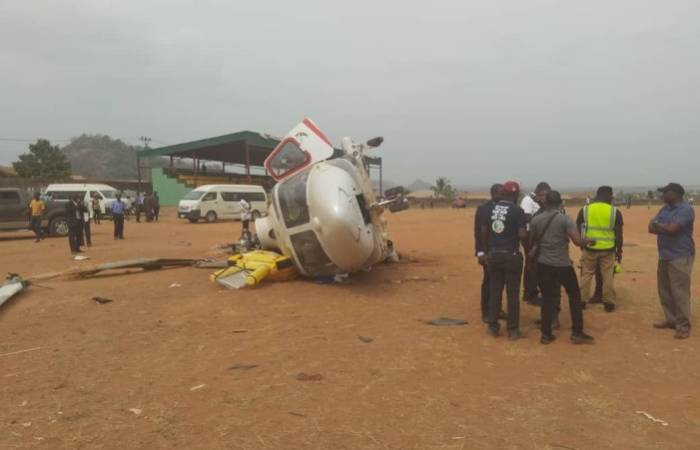VP Osinbajo: AIB concludes investigation on crashed helicopter

Seventy-two hours after an Agusta AW 139 helicopter flying Vice President Yemi Osibanjo crashed in Kabba, Kogi State, aviation agencies, led by the Accident Investigation Bureau (AIB) have concluded investigations on the accident.
The completion of the investigation came on the heels of gathering of evidence – inspection of the chopper wreckage at the crash site; interview of airline crew – pilots, engineers and other technical personnel, eyewitnesses account, laboratory testing of broken rotor and other parts of chopper.
A source closed to the AIB said the preliminary report of the accident will be released in two days, but he could not give probable cause(s) of the crash.
Another source close to Caverton Helicopters, mangers of the crashed chopper, said its insurers have arrived in the country to participate in the probe.
The source hinted that the insurers, sought permission from the AIB, for access to the crash site to carry out valuation of the wreckage and other relevant activity critical to the accident probe.
Besides the insurers, it was not clear as at Monday if the helicopter manufacturer – Agusta will participate in the inquiry.
According to the International Civil Aviation Organisation (ICAO)-prescribed aviation regulations, the aircraft manufacturers ought to participate in the investigation.
The involvement will enable the manufacturer learn useful lessons in preventing a reoccurrence; if there are issues with the equipment design or other technical hitches.
AIB’s spokesman Tunji Oketumbi said the bureau has concluded preliminary investigation on the crash, which he described as “high profile”, because of the status of the occupant in the ill-fated chopper.
He said an accident could be so described, if the aircraft was carrying many influential people; or there are many multi-nationals.
He said that will not in any way put any pressure on the AIB, which has so far utilised its internal capacity to discharge the onerous task.
Oketumbi said: “So far, the AIB has done what is statutorily required of it. We did not require any foreign assistance. We have carried out the relevant findings at the crash site and interviewed the crew and other people relevant to the operation. So, far, the helicopter wreckage has not been removed.”
He, however, took exception to the remarks attributed to Caverton Helicopters which suggested the probable cause(s) of the crash.
According to him, besides giving flight information – type of aircraft; registration number; number of occupant in the aircraft and circumstances of the accident, the airline should refrain from speculating the cause of the crash.
Doing such, Oketumbi said, will amount to pre-empting the investigation.
Recall that AgustaWestland AW139 is a 15-seat medium-sized twin-engined helicopter developed and produced principally by AgustaWestland.
It was marketed at several different roles, including VIP/corporate transport, offshore transport, fire-fighting, law enforcement, search and rescue, emergency medical service, disaster relief, and maritime patrol.
In addition to AgustaWestland’s own manufacturing facilities in Italy and the United States, the AW139 is produced in Russia by HeliVert, a joint venture between AgustaWestland and Russian Helicopters.
The AW139 was originally designed and developed jointly by Agusta and Bell Helicopters and marketed as the Agusta-Bell AB139, being redesignated AW139 when Bell withdrew from the project.
Since launching operation in 2003, the AW139 has become one of AgustaWestland’s most influential products; it has been subsequently developed into two enlarged medium-lift helicopters, the military-orientated AW149 and the AW189 for the civil market.
The AW139 is a conventional twin-engine multi-role helicopter. It has a five-bladed fully articulated main rotor with a titanium hub and composite blades and a four-bladed articulated tail rotor. It is fitted with retractable tricycle landing gear, the two aft wheels retracting into external sponsons which are also used to house emergency equipment.
It is flown by a crew of two pilots, with up to 15 passengers accommodated in three rows of five.

